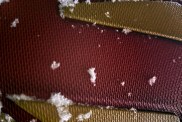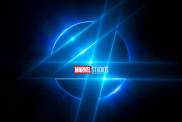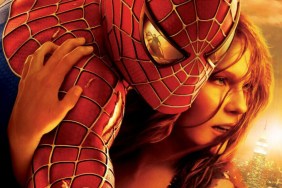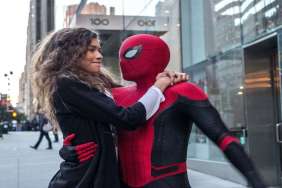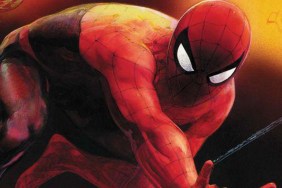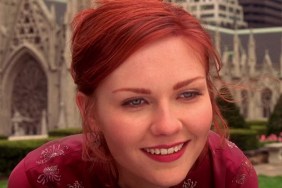‘Alan Hinkle’ has sent in this great, detailed report on things to look for when watching Spider-Man 3 and how Cleveland, Ohio relates to Spidey!
I’m one of the dozens of Clevelanders who have taken to watching the wooly world of webslinging during the lunch hour. Pete’s been right on in his reports – I’ve caught much of the same stuff.
And I’m more than happy to see they snatched the saxophone guy for a featured extra roll. I’ve passed him a handful of times and have even requested the “Spider-Man” theme while waiting to cross Ontario into Public Square. He’s a savvy guy. He set up shop next to the catering trucks on E. 9th (now W 9th in the film) and played the theme while the crew milled in for breakfast. He was bound to get “discovered.”
Anyway, since it might be fun, I thought I’d give your readers a rundown of potential “Easter Eggs” that will appear in the film – although these Easter Eggs are probably unintentional, just happy circumstance when you go on location.
Some of it’s even just “on location” trivia.
1. The blue pickup that’s been creamed half-a-dozen times is in Playhouse Square Center. Playhouse Square Center, founded in 1921 in downtown Cleveland, is the second largest theater complex in the United States (second only to New York City’s Lincoln Center). Stop your DVD and you’ll discover a historic landmark sign with an engraved Ohio that says as much.
2. Stores like “The Purple Lilac” and “Frohling Clothiers” don’t exist in Cleveland. They’re facades for the film. In fact, the lead model maker for Spider-Man 3 is Tom Frohling.
3. Next to “Frohling Clothiers” is the offices for City Year New York. This is, in fact, City Year Cleveland’s offices.
4. The action passes the Halle Building. Fans of “The Drew Carey Show” will notice it as the Winfred Louder building.
5. The First American Savings bank branch (which I assume is going to be robbed), is actually the Cleveland Trust Company building. It is largely unused, though I do believe you can still tour the building from time to time. Filmmakers cleaned it up, planted flowers, and bolted new signs to the Euclid side of the street.
6. Savvy contributors will no doubt send in pics of the Guggenheim Museum banners that adorn the lampposts down Euclid Avenue. You’ll notice that the apparent stained-glass sculpture is designed to look like a spider’s web.
7. As the action crosses E. 9th, you’ll no doubt spot a funky sculpture. My research indicates that it’s called the Triple L Extinction. Funky. There’s a subway station (that isn’t a subway station) there as well.
8. Some Euclid Ave history: Cleveland’s Euclid Avenue set the standard for the nation from the 1860s to the 1920s for beauty and sheer wealth. Today, the road is in the midst of a large reconstruction project that will include a bus rapid transit system.
At the turn of the century, Euclid Avenue’s reputation was internationally known; Baedeker’s Travel Guides called the elm-lined avenue “The Showplace of America”, and designated it as a must see for travelers from Europe.
The concentration of wealth was unparalleled; the tax valuation of the mansions along “the Avenue” far exceeded the valuation of New York’s famed Fifth Avenue in the late 19th Century.
Families living along “Millionaire’s Row” included those of John D. Rockefeller, Sylvester T. Everett, arc light inventor Charles F. Brush, and Marcus Hanna. John Hay, personal secretary to Abraham Lincoln and Secretary of State under William McKinley also resided on the Avenue until his death. Jeptha Wade, Cleveland benefactor and founder of Western Union Telegraph, lived on the Avenue, as did his son Randall.
The Avenue’s most infamous resident was con artist Cassie Chadwick, the wife of Dr. Leroy Chadwick, a mild mannered doctor who had no idea that his wife was passing herself off to bankers as the illegitimate daughter of steel magnate Andrew Carnegie.
9. And this is my favorite “easter egg” – perhaps the best reason why Cleveland should be part of the Spider-Man film:
The Cleveland Spiders major league baseball team.
The Cleveland Spiders were a Major League Baseball team that played between 1887 and 1899.
The Spiders began their history in the old American Association (then a major league) in 1887. They were a weak team in their early years, but started to improve after 1890, one year after moving to the National League and signing future Baseball Hall of Fame pitcher Cy Young.
They had one of their best ever seasons in 1892, when they finished 93-56 and finished second in the league. It was in this season that Young broke out as a pitcher. In 1895, they won the Temple Cup, the equivalent of the World Series at the time. They continued to be a winning team until their final year.
In 1899, the Spiders’ owners bought the St. Louis Browns baseball club. They decided that a good team in St. Louis would draw more fans, so they proceeded to transfer most of their stars, including Young, to St. Louis.
The last Spiders team was the worst in major league history, finishing 20-134, and 84 games behind the pennant winning Brooklyn Superbas.
The Spiders, who played out the final months of the season on the road due to lackluster attendance, were one of four teams contracted out of the National League at the end of the season. In 1901, Cleveland fielded a team in the new American League, and the Spiders were never heard from again.
Source: Alan Hinkle


